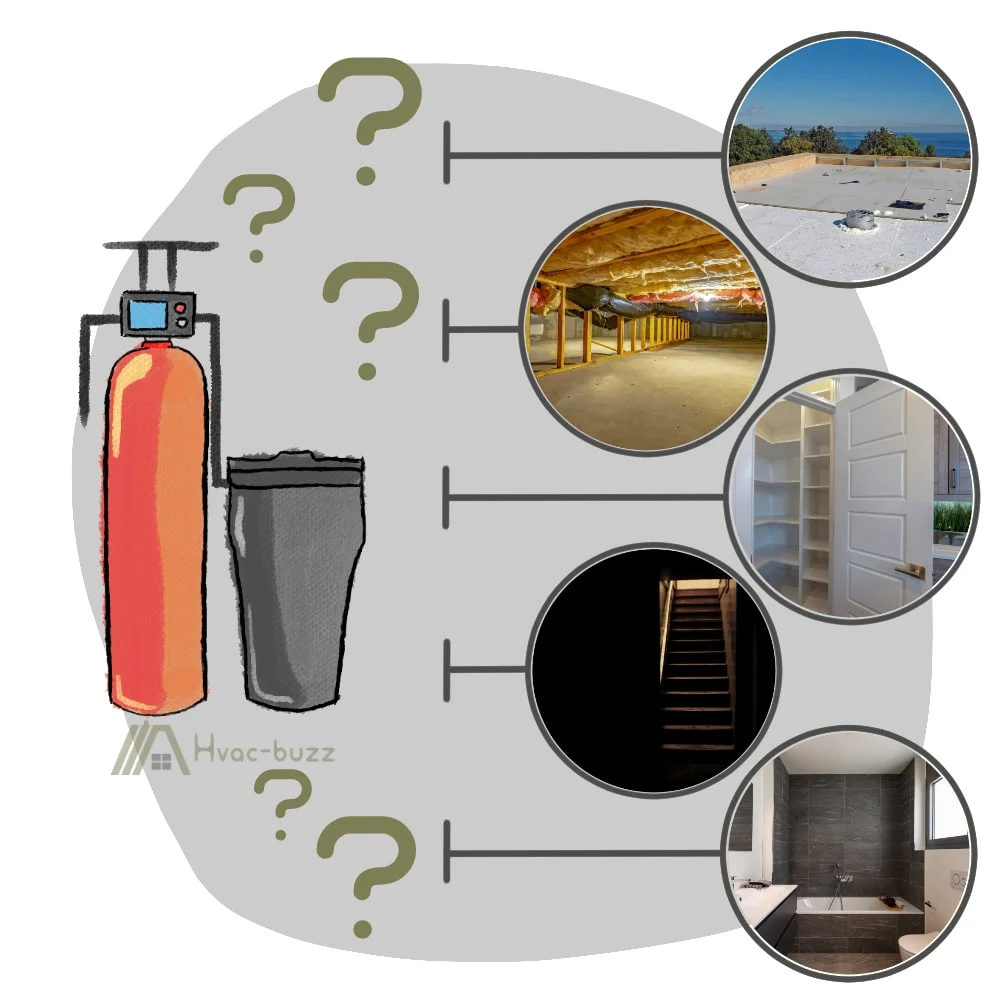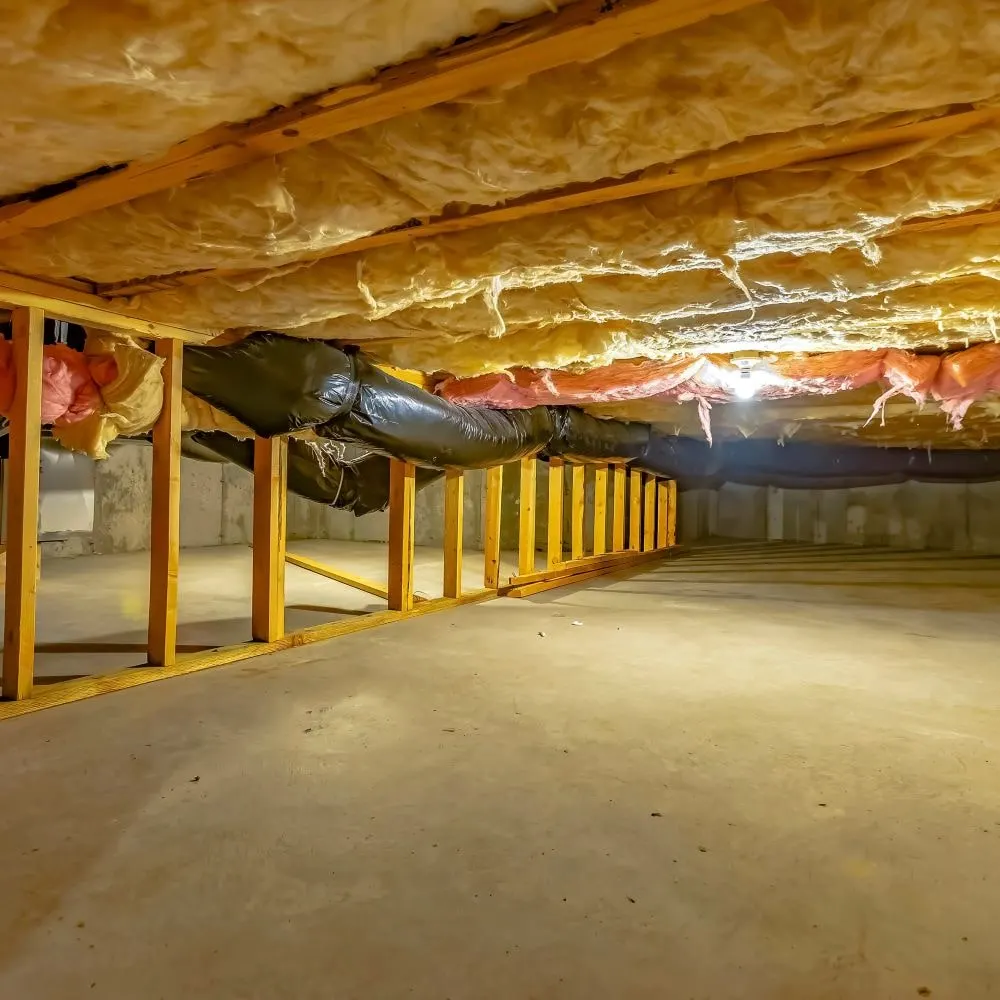You can avoid the immense issues that come with hard water—scaly pipes and damaged appliances—by installing a water softener in your home. However, the benefits of a water softener can be tempered by the inconvenience of installing and maintaining it if it is not placed in a prime location.
The crawl space of any home is an enticing, out-of-the-way spot for larger appliances, such as a water heater or a water softener, but it certainly comes with limitations and drawbacks. Let’s look over the factors that you need to consider before installing your water softener in the crawl space.

Water softeners can only be installed in crawl spaces if the crawl spaces are above the code-specified flood protection elevations. There should also be adequate room for up-right installation, maintenance, and repairs. It shouldn’t interfere with the required clearances of other appliances in the crawl space.
Codes Don’t Specify Water Softener Location
International and local codes don’t outline any specific location in which your water softener must be installed.
However, it is recommended to install the appliance near the house’s water source (where the pipes carry the water into the house). By doing this, you ensure that all the water that travels through your house has been cleaned of calcium and other minerals that could make the water hard.
Furthermore, you should install it near a power source to avoid having to run long electrical cables or extension cords.

Flood Protection May Be Required In Some Areas
If you are considering installing your water softener in the crawl space below your house, you need to consider the possibility of flooding as this could damage the softener, result in contaminated water entering your house’s water supply, and causing electrical damage if the power supply component of the water softener is exposed to water.
If you live where floods are common, you must comply with the requirements set out in the International Residential Code (IRC) Section R322. Specifically, you need to consider Section R322.1.6 and Section R322.2.2.
Let’s look at what these two sections of the IRC say:
Section R322.1.6 is designated as “Protection of mechanical, plumbing and electrical systems” says that all plumbing appliances and fixtures should be located at or higher than the code-specified elevations (which you will find in Section R322.2.1).
Section R322.2.2 is designated “Enclosed area below required elevation” and it specifically mentions crawl spaces, and it says that if such enclosed areas fall below the code-specified elevations, then they can only be used for parking (although this is not viable for a crawl space!), building access, or storage.
So, although I said that the codes do not outline specific locations for installing your water softener, it does indirectly limit the circumstances under which installing your water softening in the crawl space is prohibited. i.e., when the crawl space has too low an elevation.
Consider the Available Space Before Installation
Water Softener Repair and Maintenance
When deciding where to install your water softener, it is best to consider how much space will be available for you to be able to easily put it in place and set it up as well as conduct efficient repairs and maintenance on the appliance.
Whether you are doing your own routine inspection of all your large appliances, you have invested in a preventative maintenance plan for your water softener and a technician is monitoring it, or you have hired someone to mend a specific problem, someone will need to access the water heater.
The last thing you want to be doing is dragging yourself between dirt and cobwebs to gain access to your water softener and then also only have a few feet in which to do the required work. So, although you do not need to access the water softener often, compromising on work space clearance is really only going to cause you more problems.
Some people have surprisingly spacious crawl spaces. In such a case, it is probably a good option for installing your water softener. Otherwise, it might be best to consider a larger area where repair and maintenance can be conducted safely and with minimal discomfort.
Will It Interfere With Other Appliances?
The location of installation of your water softener depends mostly on the size of your particular water softener. Your water softener may take up significant space, so it is vital that you install it in a location where it cannot interfere with the clearances of appliances, especially when those clearances are dictated by the building codes.
If your crawl space is accessible and relatively spacious, but you already have an assortment of other appliances like a furnace, junction boxes, etc., then the water softener might be one appliance too many.
Water Softeners Have to Stand Up
The size and intricate inner workings of a water softener bring the requirement that it has to be stored and function in an upright position.
Risk of Damage
The water softener cannot lay on its side or on unlevel ground as the resin and brine tanks inside can malfunction. There is also the risk of the outer casing, valves and cover cracking, which may cause salt to leak, and your machine to ultimately stop working
Working Process
The process of water regeneration in your water softener requires it to stand up. The hard water entering the tank needs to filter through the resin beads so that the mineral ions that make the water hard are removed. If the tank were to be on its side, this process would not work as there would be no possibility for filtration, and the water would remain stagnant.
Height Clearance
Your water softener needs to fit into the crawl space standing upright. Thus, you need to make sure that the size of your water softener does not exceed the available space. Your average softener is about 3 ft by 1.5 ft and up to 6 ft high in size, so your crawl space needs to be slightly larger to allow for space for routine maintenance.
Related article: Can I Transport a Water Softener Lying Down?
How Cold Does It Get?
When you live in a colder climate, you have to consider the possibility that your plumbing pipes will freeze. Crawl spaces are not usually insulated, so if you want a functional water softener year-round, then you will either need to select an alternative location for it (I provide you with some great options at the end of this article), or you can take a look at my Tips To Prevent Pipes From Freezing in a Crawl Space.
Benefits of Water Softener in the Crawl Space
- Having a water softener installed in the crawl space under your house is a great way to utilize unused space. You won’t need to clear a spot in your garage or basement.
- Using the crawl space will save you the cost and effort of building an outdoor structure to enclose your water softener.
- As your water softener will be underground, it is not an eyesore when passing through the garage or basement.
- Your crawl space provides direct access to the house’s plumbing and electrical, making installation easier as the water softener needs direct access to a plug point and water line.
- In order for your water softener to function at its best, it cannot be exposed to direct sunlight, making the crawl space an ideal location for its installation as it is constantly cool and shaded.
Despite the appeal, there are some consequences to consider if you choose to install your water softener in the crawl space

Drawbacks of Water Softener in Crawl Space
- The IRC Section R408.4 dictates that a crawl space must have measurements of at least 18″ by 26″. Thus, if you choose to install your water softener in the crawl space, you will be limited in the size of the water softener you choose.
- As most crawl space areas are not large enough to allow for individuals to stand, or sometimes even just kneel, you may struggle to conduct repairs and general maintenance, such as replacing the salt or cleaning the filters.
- If you live in a flood-prone area, your water softener is at risk of being exposed to flood damage, and, under certain circumstances, installing your water softener in the crawl space would be against building codes.
Alternative Locations for Water Softeners
Perhaps you’re deciding against installing your water softener in the crawl space? Don’t panic! Here are those alternative options that I mentioned earlier.
- Your Basement. If you have a basement, it means you will be able to accommodate a water softener of any size.
- Your Garage. Once again, you are not limited as to the size of water softener you can install in your garage. There is also the added benefit of being able to store your salts and other necessary equipment near the machinery for easier access.
- Shed. If you have limited indoor space, it is possible to install your softener in a shed outside your house, near the required plumbing and electrical points. Just remember to build it out of direct sunlight, or your water softener’s functionality will be affected.
Sources
https://www.freshwatersystems.com/blogs/blog/what-is-a-water-softener-and-how-does-it-work
https://codes.iccsafe.org/content/IRC2021P1/chapter-3-building-planning#IRC2021P1_Pt03_Ch03_SecR322
https://www.water-rightgroup.com/resources/where-is-the-best-location-for-a-home-water-softener/
https://homewater101.com/water-softener-maintenance-made-easy
https://www.water-rightgroup.com/resources/protect-your-water-softener-with-preventive-maintenance/
https://www.peninsulawater.com/how-to-choose-the-right-location-for-your-water-softener/
https://products.geappliances.com/appliance/gea-support-search-content?contentId=21030
https://www.nachi.org/inspect-correct-vented-crawlspace.html
https://www.cascadianwater.com/2016/05/10/softener-location-what-i-need-to-know/
